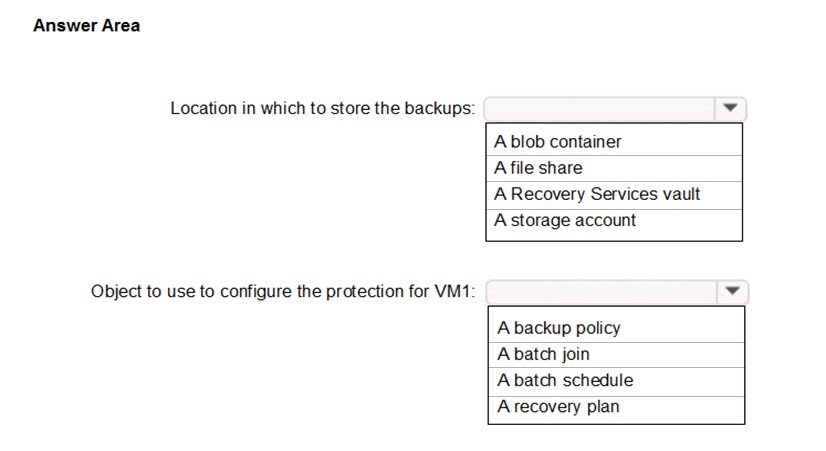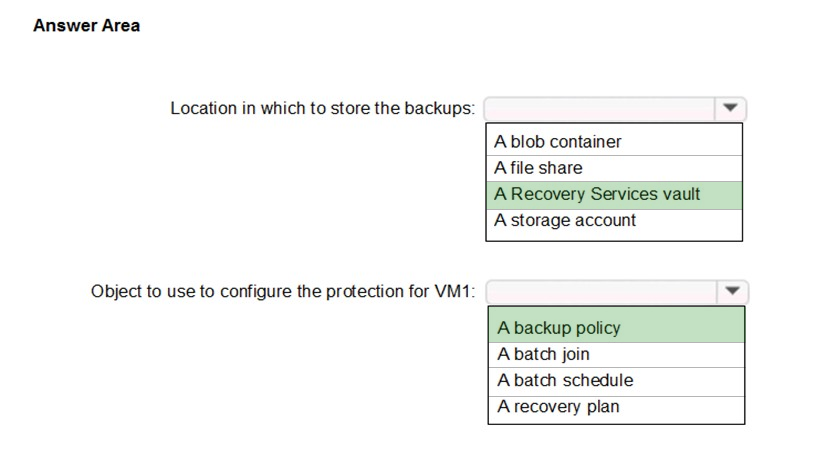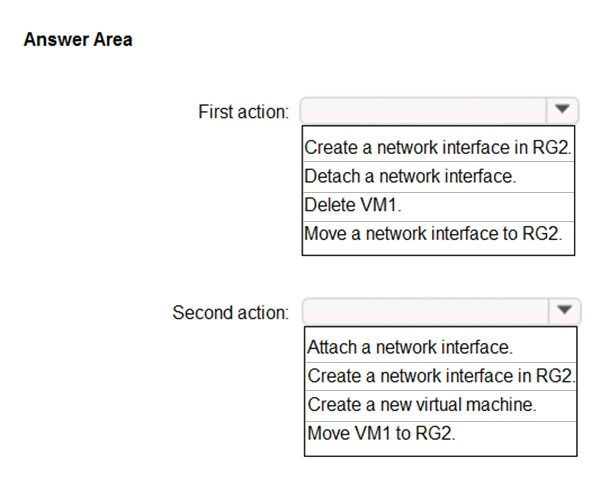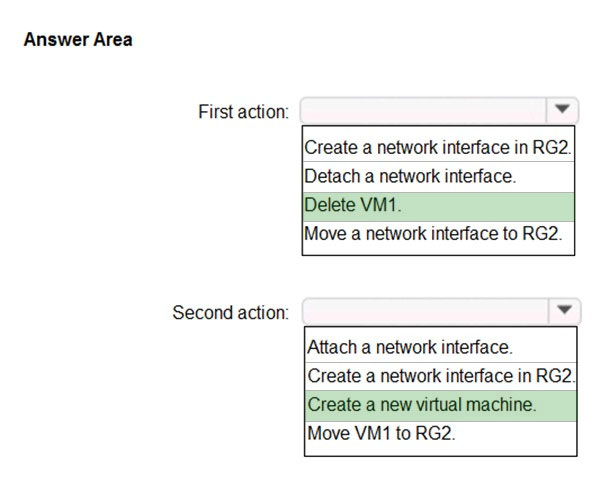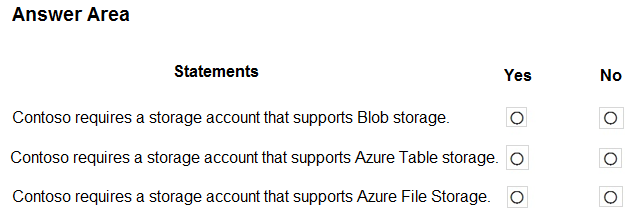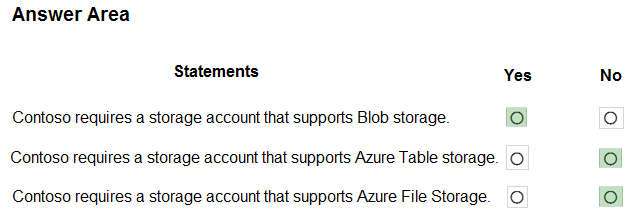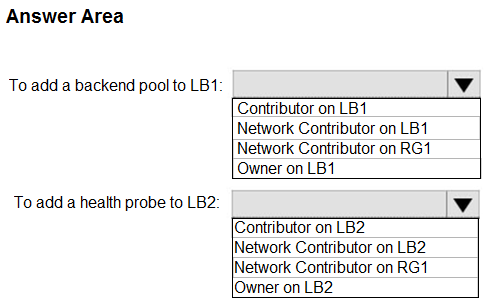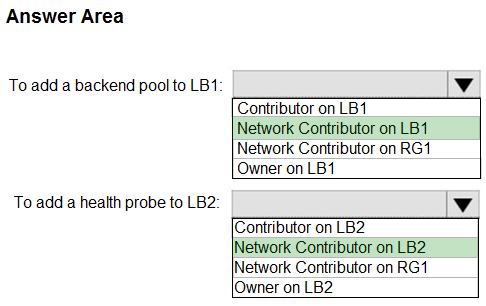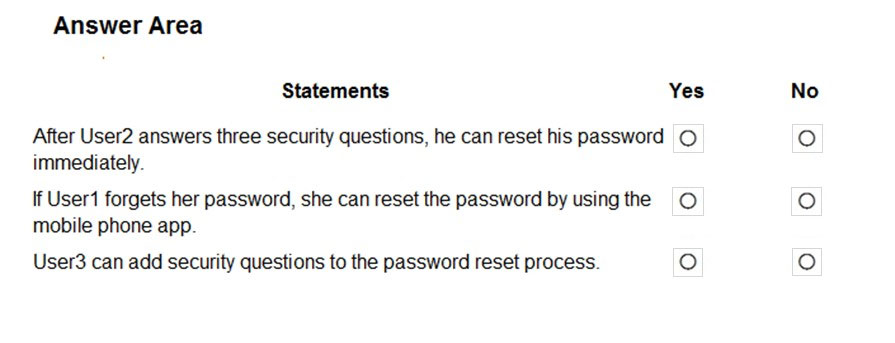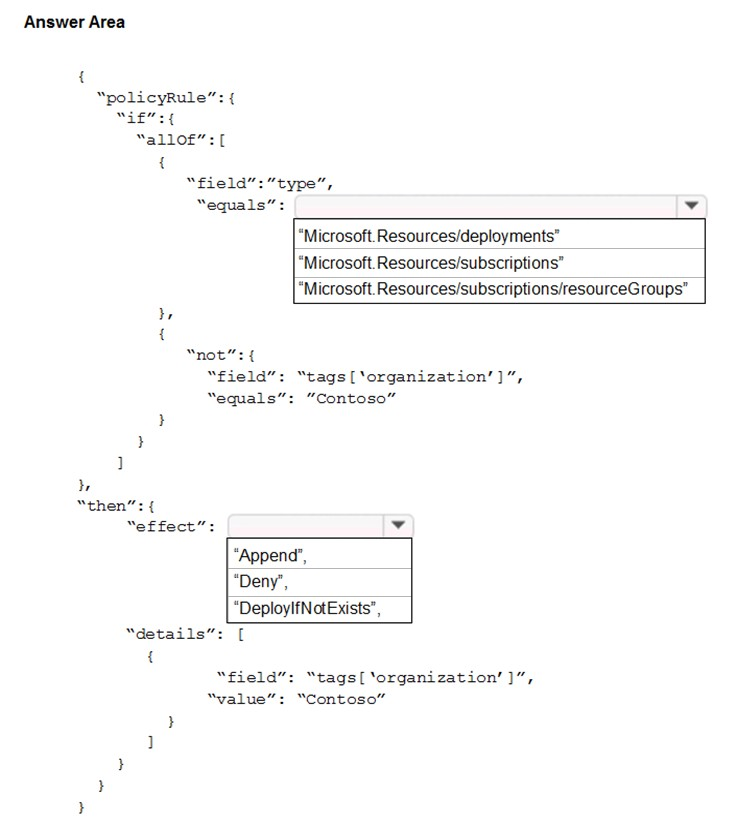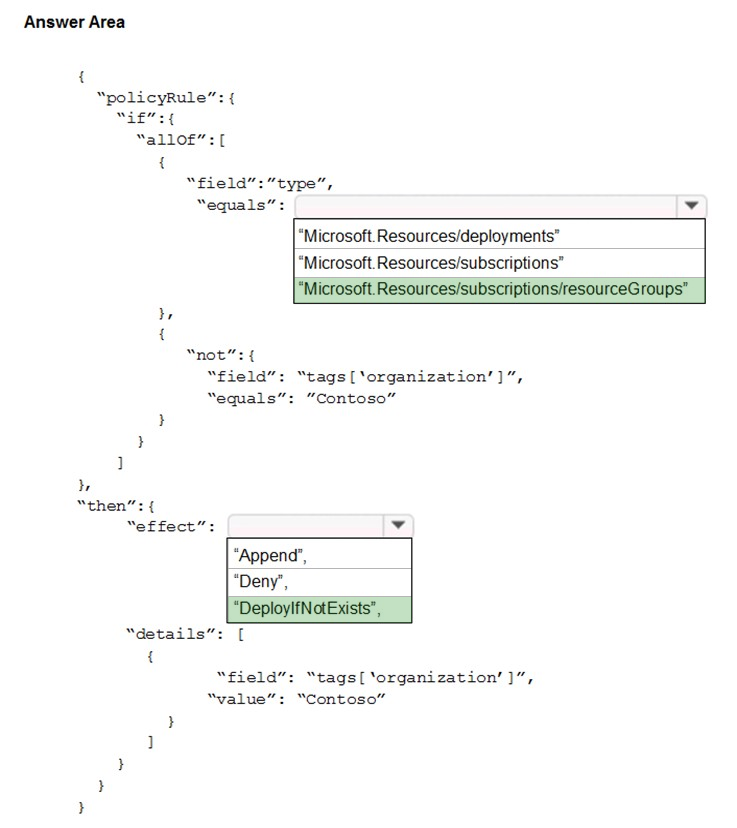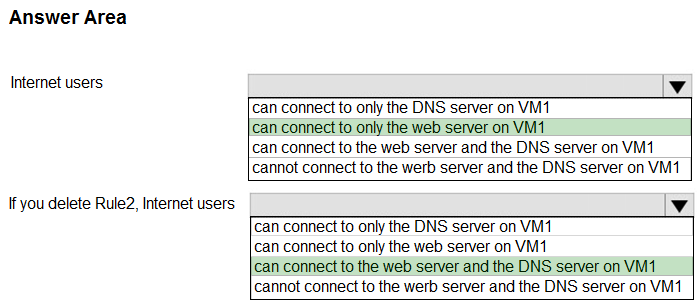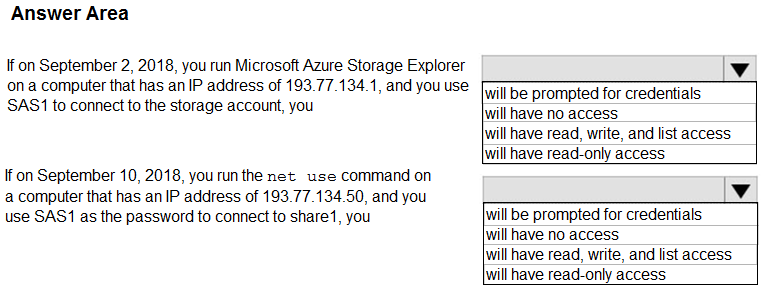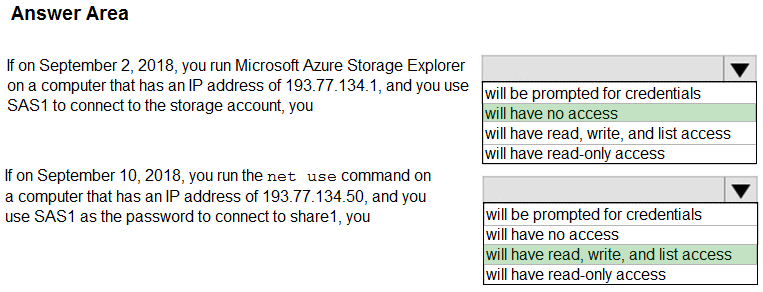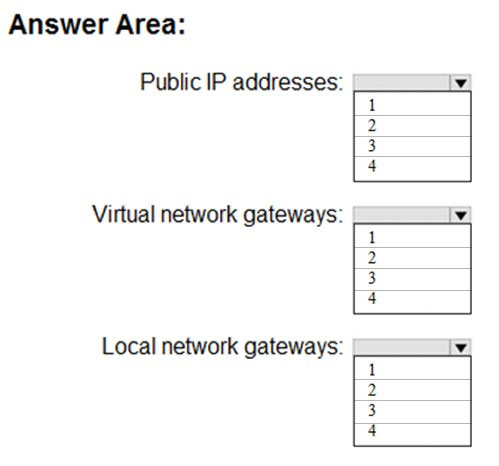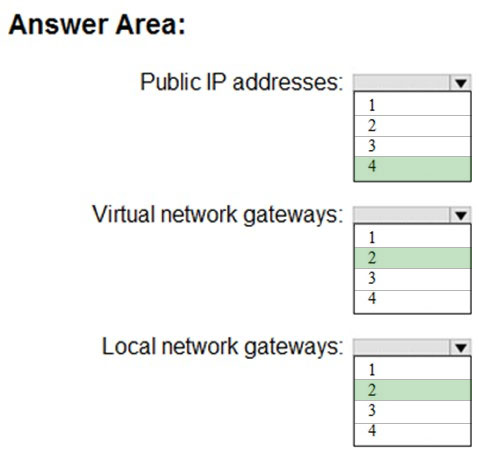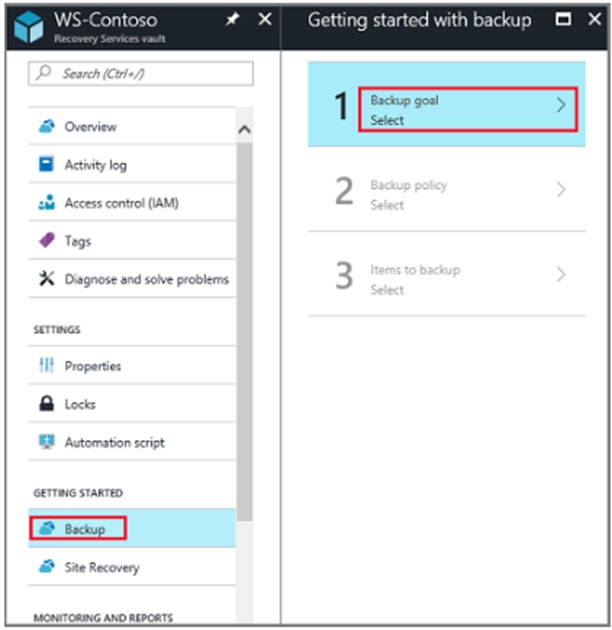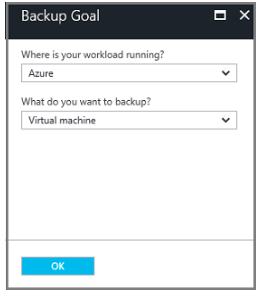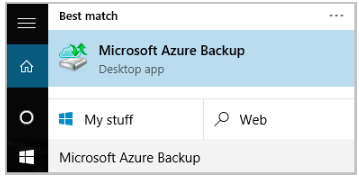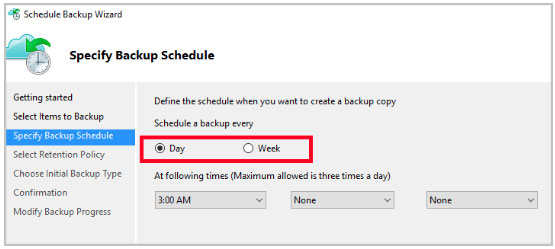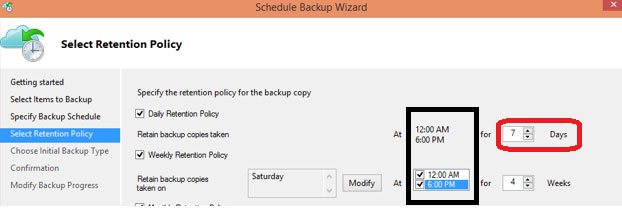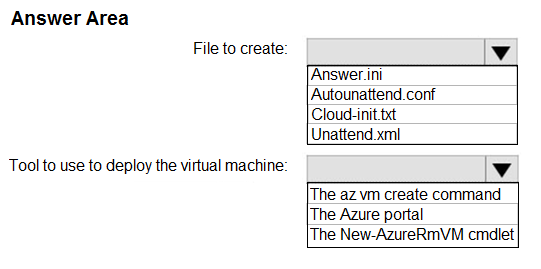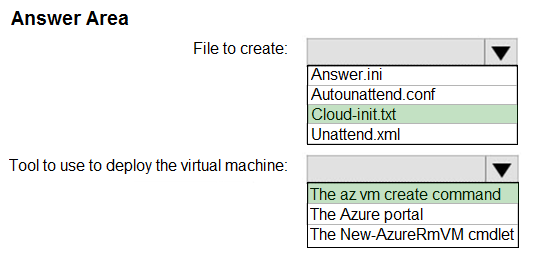AZ-103 Practice Questions Free – 50 Exam-Style Questions to Sharpen Your Skills
Are you preparing for the AZ-103 certification exam? Kickstart your success with our AZ-103 Practice Questions Free – a carefully selected set of 50 real exam-style questions to help you test your knowledge and identify areas for improvement.
Practicing with AZ-103 practice questions free gives you a powerful edge by allowing you to:
- Understand the exam structure and question formats
- Discover your strong and weak areas
- Build the confidence you need for test day success
Below, you will find 50 free AZ-103 practice questions designed to match the real exam in both difficulty and topic coverage. They’re ideal for self-assessment or final review. You can click on each Question to explore the details.
You have two Azure virtual machines named VM1 and VM2. You have two Recovery Services vaults named RSV1 and RSV2. VM2 is protected by RSV1. You need to use RSV2 to protect VM2. What should you do first?
A. From the VM2 blade, click Disaster recovery, click Replication settings, and then select RSV2 as the Recovery Services vault.
B. From the RSV2 blade, click Backup. From the Backup blade, select the backup for the virtual machine, and then click Backup.
C. From the RSV1 blade, click Backup Jobs and export the VM2 job.
D. From the RSV1 blade, click Backup items and stop the VM2 backup.
After you answer a question in this section, you will NOT be able to return to it. As a result, these questions will not appear in the review screen. You have an Azure subscription named Subscription1. Subscription1 contains a resource group named RG1. RG1 contains resources that were deployed by using templates. You need to view the date and time when the resources were created in RG1. Solution: From the RG1 blade, you click Automation script. Does this meet the goal?
A. Yes
B. No
HOTSPOT - You purchase a new Azure subscription named Subscription1. You create a virtual machine named VM1 in Subscription1. VM1 is not protected by Azure Backup. You need to protect VM1 by using Azure Backup. Backups must be created at 01:00 and stored for 30 days. What should you do? To answer, select the appropriate options in the answer area, NOTE: Each correct selection is worth one point. Hot Area:
DRAG DROP - You have two Azure virtual machines named VM1 and VM2. VM1 has a single data disk named Disk1. You need to attach Disk1 to VM2. The solution must minimize downtime for both virtual machines. Which four actions should you perform in sequence? To answer, move the appropriate actions from the list of actions to the answer area and arrange them in the correct order. Select and Place:
HOTSPOT - You have an Azure subscription. You plan to use Azure Resource Manager templates to deploy 50 Azure virtual machines that will be part of the same availability set. You need to ensure that as many virtual machines as possible are available if the fabric fails or during servicing. How should you configure the template? To answer, select the appropriate options in the answer area. NOTE: Each correct selection is worth one point. Hot Area:
You have an Azure Active Directory (Azure AD) tenant named contoso.com. Multi-factor authentication (MFA) is enabled for all users. You need to provide users with the ability to bypass MFA for 10 days on devices to which they have successfully signed in by using MFA. What should you do?
A. From the multi-factor authentication page, configure the users’ settings.
B. From Azure AD, create a conditional access policy.
C. From the multi-factor authentication page, configure the service settings.
D. From the MFA blade in Azure AD, configure the MFA Server settings.
You have an Azure subscription named Subscription1. You deploy a Linux virtual machine named VM1 to Subscription1. You need to monitor the metrics and the logs of VM1. What should you use?
A. the AzurePerformanceDiagnostics extension
B. Azure HDInsight
C. Linux Diagnostic Extension (LAD) 3.0
D. Azure Analysis Services
After you answer a question in this section, you will NOT be able to return to it. As a result, these questions will not appear in the review screen. You have an Azure subscription named Subscription1. Subscription1 contains a resource group named RG1. RG1 contains resources that were deployed by using templates. You need to view the date and time when the resources were created in RG1. Solution: From the Subscriptions blade, you select the subscription, and then click Resource providers. Does this meet the goal?
A. Yes
B. No
You set the multi-factor authentication status for a user named admin1@contoso.com to Enabled. Admin1 accesses the Azure portal by using a web browser. Which additional security verifications can Admin1 use when accessing the Azure portal?
A. a phone call, a text message that contains a verification code, and a notification or a verification code sent from the Microsoft Authenticator app
B. an app password, a text message that contains a verification code, and a notification sent from the Microsoft Authenticator app
C. an app password, a text message that contains a verification code, and a verification code sent from the Microsoft Authenticator app
D. a phone call, an email message that contains a verification code, and a text message that contains an app password
HOTSPOT - You have an Azure subscription named Subscription1. You plan to deploy an Ubuntu Server virtual machine named VM1 to Subscription1. You need to perform a custom deployment of the virtual machine. A specific trusted root certification authority (CA) must be added during the deployment. What should you do? To answer, select the appropriate options in the answer area. NOTE: Each correct selection is worth one point. Hot Area:
HOTSPOT - You have an Azure subscription named Subscription1. Subscription1 contains the resources in the following table.VNet1 is in RG1. VNet2 is in RG2. There is no connectivity between VNet1 and VNet2. An administrator named Admin1 creates an Azure virtual machine named VM1 in RG1. VM1 uses a disk named Disk1 and connects to VNet1. Admin1 then installs a custom application in VM1. You need to move the custom application to VNet2. The solution must minimize administrative effort. Which two actions should you perform? To answer, select the appropriate options in the answer area. NOTE: Each correct selection is worth one point. Hot Area:
SIMULATION - Please wait while the virtual machine loads. Once loaded, you may proceed to the lab section. This may take a few minutes, and the wait time will not be deducted from your overall test time. When the Next button is available, click it to access the lab section. In this section, you will perform a set of tasks in a live environment. While most functionality will be available to you as it would be in a live environment, some functionality (e.g, copy and paste, ability to navigate to external websites) will not be possible by design. Scoring is based on the outcome of performing the tasks stated in the lab. In other words, it doesn't matter how you accomplish the task, if you successfully perform it, you will earn credit for that task. Labs are not timed separately, and this exam may have more than one lab that you must complete. You can use as much time as you would like to complete each lab. But, you should manage your time appropriately to ensure that you are able to complete the lab(s) and all other sections of the exam in the time provided. Please note that once you submit your work by clicking the Next button within a lab, you will NOT be able to return to the lab. You may now click next to proceed to the lab.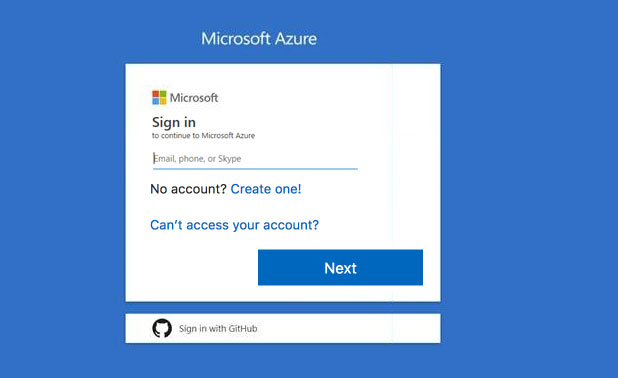
You need to deploy two Azure virtual machines named VM1003a and VM1003b based on an Ubuntu Server image. The deployment must meet the following requirements: ✑ Provide a Service Level Agreement (SLA) of 99.95 percent availability. ✑ Use managed disks. What should you do from the Azure portal?
You have an Active Directory forest named contoso.com. You install and configure Azure AD Connect to use password hash synchronization as the single sign-on (SSO) method. Staging mode is enabled. You review the synchronization results and discover that the Synchronization Service Manager does not display any sync jobs. You need to ensure that the synchronization completes successfully. What should you do?
A. Run Azure AD Connect and set the SSO method to Pass-through Authentication.
B. From Synchronization Service Manager, run a full import.
C. From Azure PowerShell, run Start-AdSyncSyncCycle “”PolicyType Initial.
D. Run Azure AD Connect and disable staging mode.
HOTSPOT - You have an Azure subscription. You plan to use Azure Resource Manager templates to deploy 50 Azure virtual machines that will be part of the same availability set. You need to ensure that as many virtual machines as possible are available if the fabric fails or during servicing. How should you configure the template? To answer, select the appropriate options in the answer area. NOTE: Each correct selection is worth one point. Hot Area:
DRAG DROP - You have an on-premises file server named Server1 that runs Windows Server 2016. You have an Azure subscription that contains an Azure file share. You deploy an Azure File Sync Storage Sync Service, and you create a sync group. You need to synchronize files from Server1 to Azure. Which three actions should you perform in sequence? To answer, move the appropriate actions from the list of actions to the answer area and arrange them in the correct order. Select and Place:
HOTSPOT - You have an Azure subscription named Subscription1. Subscription1 contains two Azure virtual machines named VM1 and VM2. VM1 and VM2 run Windows Server 2016. VM1 is backed up daily by Azure Backup without using the Azure Backup agent. VM1 is affected by ransomware that encrypts data. You need to restore the latest backup of VM1. To which location can you restore the backup? To answer, select the appropriate options in the answer area. NOTE: Each correct selection is worth one point. Hot Area:
You have an Azure virtual network named VNet1 that contains a subnet named Subnet1. Subnet1 contains three Azure virtual machines. Each virtual machine has a public IP address. The virtual machines host several applications that are accessible over port 443 to user on the Internet. Your on-premises network has a site-to-site VPN connection to VNet1. You discover that virtual machines can be accessed by using the Remote Desktop Protocol (RDP) from the Internet and from the on-premises network. You need to prevent RDP access to the virtual machines from the Internet, unless the RDP connection is established from the on-premises network. The solution must ensure that all the applications can still be accesses by the Internet users. What should you do?
A. Create a deny rule in a network security group (NSG) that is linked to Subnet1.
B. Modify the address space of Subnet1.
C. Modify the address space of the local network gateway.
D. Remove the public IP addresses from the virtual machines.
You have a resource group named RG1. RG1 contains an Azure Storage account named storageaccount1 and a virtual machine named VM1 that runs Windows Server 2016. Storageaccount1 contains the disk files for VM1. You apply a ReadOnly lock to RG1. What can you do from the Azure portal?
A. Generate an automation script for RG1.
B. View the keys of storageaccount1.
C. Start VM1.
D. Upload a blob to storageaccount1.
DRAG DROP - You have an Azure Linux virtual machine that is protected by Azure Backup. One week ago, two files were deleted from the virtual machine. You need to restore the deleted files to an on-premises computer as quickly as possible. Which four actions should you perform in sequence? To answer, move the appropriate actions from the list of actions to the answer area and arrange them in the correct order. Select and Place:
After you answer a question in this section, you will NOT be able to return to it. As a result, these questions will not appear in the review screen. You have an Azure virtual machine named VM1. VM1 was deployed by using a custom Azure Resource Manager template named ARM1.json. You receive a notification that VM1 will be affected by maintenance. You need to move VM1 to a different host immediately. Solution: From the Update management blade, you click Enable. Does this meet the goal?
A. Yes
B. No
HOTSPOT - You have an Azure subscription named Subscription1 that contains a resource group named RG1. In RG1, you create an internal load balancer named LB1 and a public load balancer named LB2. You need to ensure that an administrator named Admin1 can manage LB1 and LB2. The solution must follow the principle of least privilege. Which role should you assign to Admin1 for each task? To answer, select the appropriate options in the answer area. NOTE: Each correct selection is worth one point. Hot Area:
HOTSPOT - You need to identify the storage requirements for Contoso. For each of the following statements, select Yes if the statement is true. Otherwise, select No. NOTE: Each correct selection is worth one point. Hot Area:
HOTSPOT - You have an Azure subscription named Subscription1 that contains a resource group named RG1. In RG1, you create an internal load balancer named LB1 and a public load balancer named LB2. You need to ensure that an administrator named Admin1 can manage LB1 and LB2. The solution must follow the principle of least privilege. Which role should you assign to Admin1 for each task? To answer, select the appropriate options in the answer area. NOTE: Each correct selection is worth one point. Hot Area:
HOTSPOT - You have an Azure subscription named Subscription1 that has a subscription ID of c276fc76-9cd4-44c9-99a7-4fd71546436e. You need to create a custom RBAC role named CR1 that meets the following requirements: ✑ Can be assigned only to the resource groups in Subscription1 ✑ Prevents the management of the access permissions for the resource groups ✑ Allows the viewing, creating, modifying, and deleting of resource within the resource groups What should you specify in the assignable scopes and the permission elements of the definition of CR1? To answer, select the appropriate options in the answer area. NOTE: Each correct selection is worth one point. Hot Area:
After you answer a question in this section, you will NOT be able to return to it. As a result, these questions will not appear in the review screen. You have an Azure Active Directory (Azure AD) tenant named Adatum and an Azure Subscription named Subscription1. Adatum contains a group named Developers. Subscription1 contains a resource group named Dev. You need to provide the Developers group with the ability to create Azure logic apps in the Dev resource group. Solution: On Dev, you assign the Contributor role to the Developers group. Does this meet the goal?
A. Yes
B. No
HOTSPOT - You have an Azure Active Directory (Azure AD) tenant named contoso.onmicrosoft.com that contains the users shown in the following table.You enable password reset for contoso.onmicrosoft.com as shown in the Password Reset exhibit. (Click the Password Reset tab.)
You configure the authentication methods for password reset as shown in the Authentication Methods exhibit. (Click the Authentication Methods tab.)
For each of the following statements, select Yes if the statement is true. Otherwise, select No. NOTE: Each correct selection is worth one point. Hot Area:
You have an Azure subscription named Subscription1 and two Azure Active Directory (Azure AD) tenants named Tenant1 and Tenant2. Subscription1 is associated to Tenant1. Multi-factor authentication (MFA) is enabled for all the users in Tenant1. You need to enable MFA for the users in Tenant2. The solution must maintain MFA for Tenant1. What should you do first?
A. Change the directory for Subscription1.
B. Configure the MFA Server setting in Tenant1.
C. Create and link a subscription to Tenant2.
D. Transfer the administration of Subscription1 to a global administrator of Tenant2.
You have an Azure Active Directory (Azure AD) tenant named contoso.onmicrosoft.com. You hire a temporary vendor. The vendor uses a Microsoft account that has a sign-in of user1@outlook.com . You need to ensure that the vendor can authenticate to the tenant by using user1@outlook.com . What should you do?
A. From the Azure portal, add a custom domain name, create a new Azure AD user, and then specify user1@outlook.com as the username.
B. From Azure Cloud Shell, run the New-AzureADUser cmdlet and specify the “”UserPrincipalName user1@outlook.com parameter.
C. From the Azure portal, add a new guest user, and then specify user1@outlook.com as the email address.
D. From Windows PowerShell, run the New-AzureADUser cmdlet and specify the “”UserPrincipalName user1@outlook.com parameter.
HOTSPOT - You have an Azure subscription. You need to implement a custom policy that meets the following requirements: ✑ Ensures that each new resource group in the subscription has a tag named organization set to a value of Contoso ✑ Ensures that resource groups can be created from the Azure portal ✑ Ensures that compliance reports in the Azure portal are accruable How should you complete the policy? To answer, select the appropriate options in the answer area. NOTE: Each correct selection is worth one point. Hot Area:
You discover that VM3 does NOT meet the technical requirements. You need to verify whether the issue relates to the NSGs. What should you use?
A. Diagram in VNet1
B. the security recommendations in Azure Advisor
C. Diagnostic settings in Azure Monitor
D. Diagnose and solve problems in Traffic Manager profiles
E. IP flow verify in Azure Network Watcher
You have an azure subscription named Subscription1 that has the following providers registered: ✑ Authorization ✑ Automation ✑ Resources ✑ Compute ✑ KeyVault ✑ Network ✑ Storage ✑ Billing ✑ Web Subscription1 contains an Azure virtual machine named VM1 that has the following configurations: ✑ Private IP address: 10.0.0.4 (dynamic) ✑ Network security group (NSG): NSG1 ✑ Public IP address: None ✑ Availability set: AVSet ✑ Subnet: 10.0.0.0/24 ✑ Managed disks: No ✑ Location: East US You need to record all the successful and failed connection attempts to VM1. Which three actions should you perform? Each correct answer presents part of the solution. NOTE: Each correct selection is worth one point.
A. Create an Azure Storage account.
B. Register the Microsoft.Insights resource provider.
C. Add an Azure Network Watcher connection monitor.
D. Enable Azure Network Watcher in the East US Azure region.
E. Enable Azure Network Watcher flow logs.
F. Register the Microsoft.LogAnalytics provider.
HOTSPOT - You are creating an Azure load balancer. You need to add an IPv6 load balancing rule to the load balancer. How should you complete the Azure PowerShell script? To answer, select the appropriate options in the answer area. NOTE: Each correct selection is worth one point. Hot Area:
After you answer a question in this section, you will NOT be able to return to it. As a result, these questions will not appear in the review screen. You have an Azure virtual machine named VM1 that runs Windows Server 2016. You need to create an alert in Azure when more than two error events are logged to the System log on VM1 within an hour. Solution: You create an event subscription on VM1. You create an alert in Azure Monitor and specify VM1 as the source. Does this meet the goal?
A. Yes
B. No
HOTSPOT - You are evaluating the name resolution for the virtual machines after the planned implementation of the Azure networking infrastructure. For each of the following statements, select Yes if the statement is true. Otherwise, select No. Hot Area:
HOTSPOT - You have an Azure subscription named Subscription1. Subscription1 contains a virtual machine named VM1. You install and configure a web server and a DNS server on VM1. VM1 has the effective network security rules shown in the following exhibit.Use the drop-down menus to select the answer choice that completes each statement based on the information presented. NOTE: Each correct selection is worth one point. Hot Area:
After you answer a question in this section, you will NOT be able to return to it. As a result, these questions will not appear in the review screen. Your company registers a domain name of contoso.com. You create an Azure DNS zone named contoso.com, and then you add an A record to the zone for a host named www that has an IP address of 131.107.1.10. You discover that Internet hosts are unable to resolve www.contoso.com to the 131.107.1.10 IP address. You need to resolve the name resolution issue. Solution: You modify the name servers at the domain registrar. Does this meet the goal?
A. Yes
B. No
You have two Azure Active Directory (Azure AD) tenants named contoso.com and fabrikam.com. You have a Microsoft account that you use to sign in to both tenants. You need to configure the default sign-in tenant for the Azure portal. What should you do?
A. From Azure Cloud Shell, run Set-AzureRmSubscription.
B. From Azure Cloud Shell, run Set-AzureRmContext.
C. From the Azure portal, configure the portal settings.
D. From the Azure portal, change the directory.
HOTSPOT - You have an Azure subscription named Subscription1. In Subscription1, you create an Azure file share named share1. You create a shared access signature (SAS) named SAS1 as shown in the following exhibit.To answer, select the appropriate options in the answer area. NOTE: Each correct selection is worth one point. Hot Area:
HOTSPOT - You have an on-premises data center and an Azure subscription. The data center contains two VPN devices. The subscription contains an Azure virtual network named VNet1. VNet1 contains a gateway subnet. You need to create a site-to-site VPN. The solution must ensure that is a single instance of an Azure VPN gateway fails, or a single on-premises VPN device fails, the failure will not cause an interruption that is longer than two minutes. What is the minimum number of public IP addresses, virtual network gateways, and local network gateways required in Azure? To answer, select the appropriate options in the answer area. NOTE: Each correct selection is worth one point. Hot Area:
After you answer a question in this section, you will NOT be able to return to it. As a result, these questions will not appear in the review screen. You have an Azure subscription that contains the resources shown in the following table.VM1 connects to VNET1. You need to connect VM1 to VNET2. Solution: You delete VM1. You recreate VM1, and then you create a new network interface for VM1. Does this meet the goal?
A. Yes
B. No
After you answer a question in this section, you will NOT be able to return to it. As a result, these questions will not appear in the review screen. You have an Azure subscription named Subscription1. Subscription1 contains a resource group named RG1. RG1 contains resources that were deployed by using templates. You need to view the date and time when the resources were created in RG1. Solution: From the Subscriptions blade, you select the subscription, and then click Programmatic deployment. Does this meet the goal?
A. Yes
B. No
After you answer a question in this section, you will NOT be able to return to it. As a result, these questions will not appear in the review screen. Your company registers a domain name of contoso.com. You create an Azure DNS zone named contoso.com, and then you add an A record to the zone for a host named www that has an IP address of 131.107.1.10. You discover that Internet hosts are unable to resolve www.contoso.com to the 131.107.1.10 IP address. You need to resolve the name resolution issue. Solution: You add an NS record to the contoso.com Azure DNS zone. Does this meet the goal?
A. Yes
B. No
HOTSPOT - You have an Azure subscription named Subscription1 that has a subscription ID of c276fc76-9cd4-44c9-99a7-4fd71546436e. You need to create a custom RBAC role named CR1 that meets the following requirements: ✑ Can be assigned only to the resource groups in Subscription1 ✑ Prevents the management of the access permissions for the resource groups ✑ Allows the viewing, creating, modifying, and deleting of resource within the resource groups What should you specify in the assignable scopes and the permission elements of the definition of CR1? To answer, select the appropriate options in the answer area. NOTE: Each correct selection is worth one point. Hot Area:
HOTSPOT - You have an Azure subscription. You plan to use Azure Resource Manager templates to deploy 50 Azure virtual machines that will be part of the same availability set. You need to ensure that as many virtual machines as possible are available if the fabric fails or during servicing. How should you configure the template? To answer, select the appropriate options in the answer area. NOTE: Each correct selection is worth one point. Hot Area:
SIMULATION - Please wait while the virtual machine loads. Once loaded, you may proceed to the lab section. This may take a few minutes, and the wait time will not be deducted from your overall test time. When the Next button is available, click it to access the lab section. In this section, you will perform a set of tasks in a live environment. While most functionality will be available to you as it would be in a live environment, some functionality (e.g, copy and paste, ability to navigate to external websites) will not be possible by design. Scoring is based on the outcome of performing the tasks stated in the lab. In other words, it doesn't matter how you accomplish the task, if you successfully perform it, you will earn credit for that task. Labs are not timed separately, and this exam may have more than one lab that you must complete. You can use as much time as you would like to complete each lab. But, you should manage your time appropriately to ensure that you are able to complete the lab(s) and all other sections of the exam in the time provided. Please note that once you submit your work by clicking the Next button within a lab, you will NOT be able to return to the lab. You may now click next to proceed to the lab. Use the following login credentials as needed: Azure Username: XXXXXXX - Azure Password: XXXXXXX - The following information is for technical support purposes only: Lab Instance: 9172796 -You plan to prevent users from accidentally deleting blob data from Azure. You need to ensure that administrators can recover any blob data that is deleted accidentally from the storagelod9272261 storage account for 14 days after the deletion occurred. What should you do from the Azure portal?
You have an Azure subscription named Subscription1. Subscription1 contains a virtual machine named VM1. You have a computer named Computer1 that runs Windows 10. Computer1 is connected to the Internet. You add a network interface named Interface1 to VM1 as shown in the exhibit. (Click the Exhibit tab.)From Computer1, you attempt to connect to VM1 by using Remote Desktop, but the connection fails. You need to establish a Remote Desktop connection to VM1. What should you do first?
A. Change the priority of the RDP rule.
B. Attach a network interface.
C. Delete the DenyAllInBound rule.
D. Start VM1.
You have an Azure subscription that contains a virtual network named VNet1. VNet1 contains four subnets named Gateway, Perimeter, NVA, and Production. The NVA subnet contains two network virtual appliances (NVAs) that will perform network traffic inspection between the Perimeter subnet and the Production subnet. You need to implement an Azure load balancer for the NVAs. The solution must meet the following requirements: ✑ The NVAs must run in an active-active configuration that uses automatic failover. ✑ The NVAs must load balance traffic to two services on the Production subnet. The services have different IP addresses. Which three actions should you perform? Each correct answer presents part of the solution. NOTE: Each correct selection is worth one point.
A. Add two load balancing rules that have HA Ports enabled and Floating IP disabled.
B. Add a frontend IP configuration, two backend pools, and a health probe.
C. Add two load balancing rules that have HA Ports and Floating IP enabled.
D. Deploy a standard load balancer.
E. Deploy a basic load balancer.
F. Add a frontend IP configuration a backend pool, and a health probe.
HOTSPOT - You are evaluating the name resolution for the virtual machines after the planned implementation of the Azure networking infrastructure. For each of the following statements, select Yes if the statement is true. Otherwise, select No. Hot Area:
You have five Azure virtual machines that run Windows Server 2016. The virtual machines are configured as web servers. You have an Azure load balancer named LB1 that provides load balancing services for the virtual machines. You need to ensure that visitors are serviced by the same web server for each request. What should you configure?
A. Protocol to UDP
B. Session persistence to None
C. Session persistence to Client IP
D. Idle Time-out (minutes) to 20
HOTSPOT - You have an Azure subscription named Subscription1. You plan to deploy an Ubuntu Server virtual machine named VM1 to Subscription1. You need to perform a custom deployment of the virtual machine. A specific trusted root certification authority (CA) must be added during the deployment. What should you do? To answer, select the appropriate options in the answer area. NOTE: Each correct selection is worth one point. Hot Area:
Free Access Full AZ-103 Practice Questions Free
Want more hands-on practice? Click here to access the full bank of AZ-103 practice questions free and reinforce your understanding of all exam objectives.
We update our question sets regularly, so check back often for new and relevant content.
Good luck with your AZ-103 certification journey!


